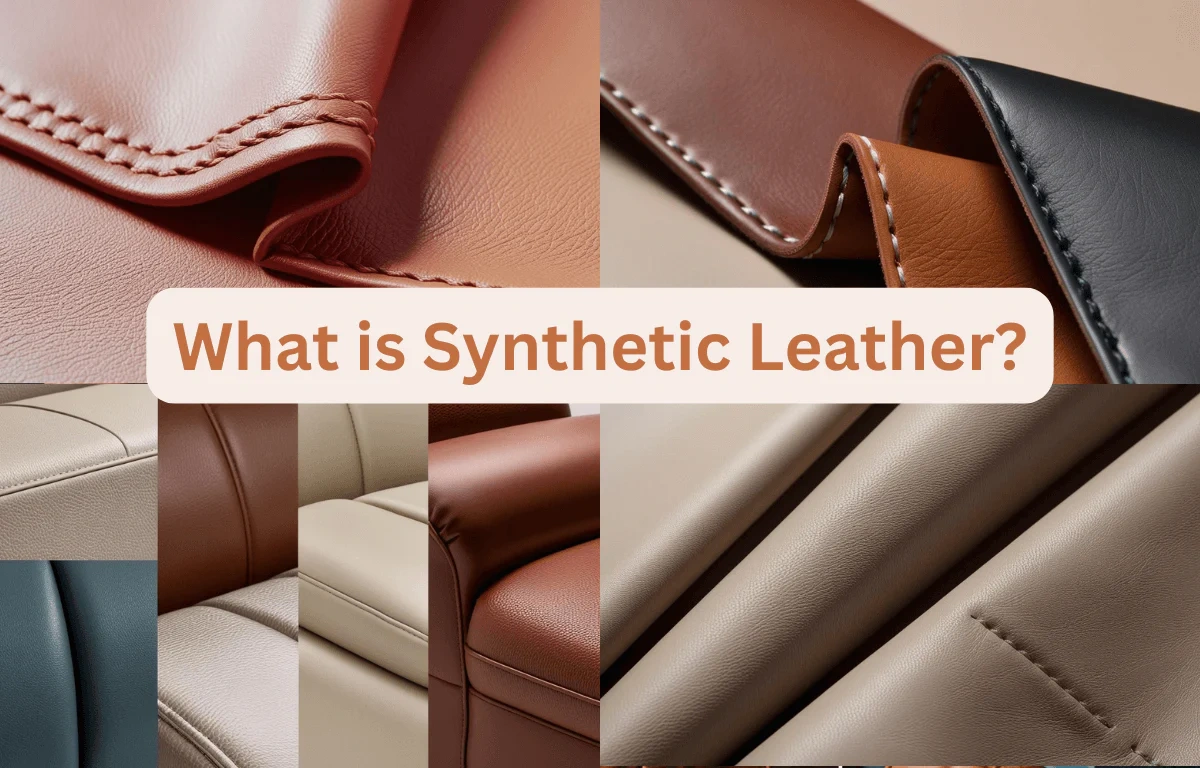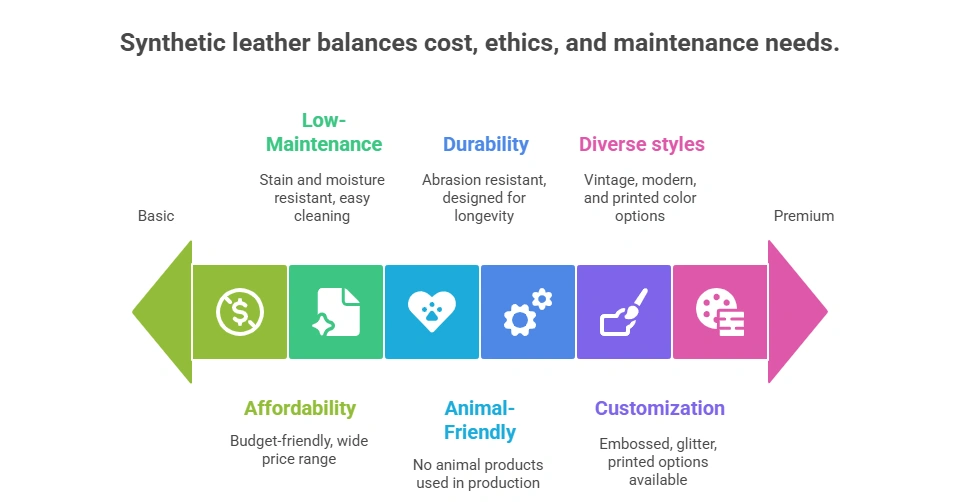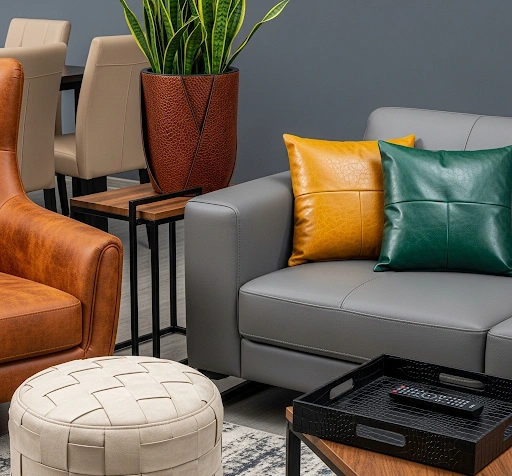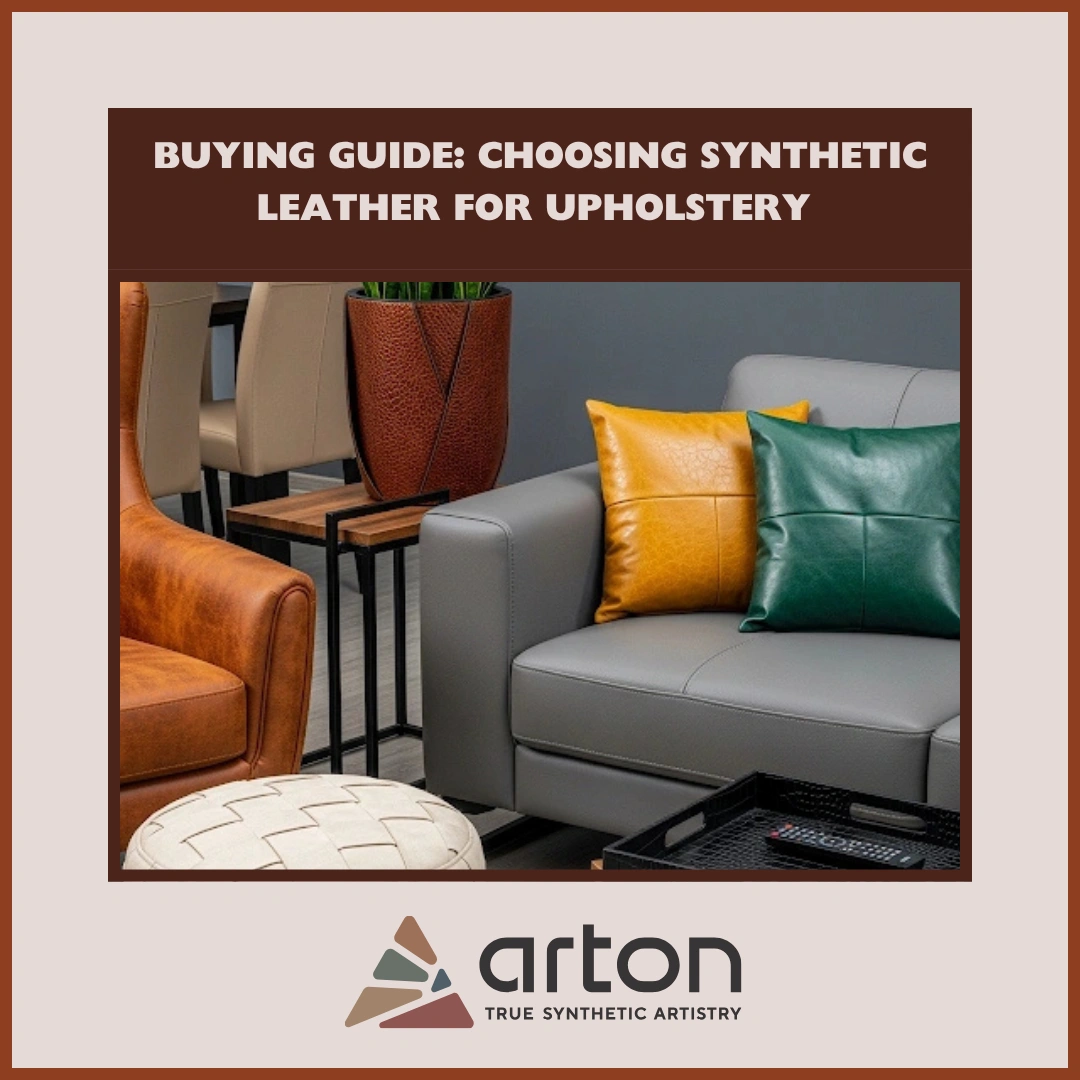04 August, 2025
Whether you are upholstering your home or office or any other commercial premises, the upholstery material you use can change everything in terms of blend and functionality. Synthetic leather has gained the popularity of upholstery with its low price, ability to style and its practicality. All the facts you need to know before making a decision to use synthetic leather in the Upholstery of your furniture.
What is Synthetic Leather?

Synthetic leather, also known as artificial leather, faux leather, or synthetic leatherette, is a non-leather material created to resemble real leather. Types such as PU (polyurethane) leather, polyvinyl chloride leather, and microfiber faux leather are popular ones. These materials are created unlike the traditional animal leather, though, which make them much more flexible in design, durable, and easier to control in expense when constructed out of plastic polymers overlaid on fabric backing.
Why Choose Synthetic Leather for Upholstery?

- Affordability: Synthetics are cheaper than authentic real leather and available in different cost ranges.
- Diverse styles: Can be found in vintage colors, such as black synthetic leather or brown synthetic leather, as well as modern choices:
- white synthetic leather
- red synthetic leather
- green synthetic leather
- pink synthetic leather
- synthetic leather suppliers
- printed synthetic leather
- purple synthetic leather
- yellow synthetic leather
- grey synthetic leather
- gold synthetic leather
- Durability: Contemporary artificial leathers, top grade PVC leather, are designed to be abrasion resistant as well as lasting long.
- Low-Maintenance: The upholstery faux leather is stain-resistant, moisture resistant, and requires only a moist cloth to wipe it off.
- Customization: Embossed synthetic leather, glitter synthetic leather and printed synthetic leather give you even additional design possibilities.
- Animal-Friendly: Artificial leather upholstery is not made using animals.
Types of Synthetic Leather for Upholstery
- PU Synthetic Leather: Comfortable touch and soft to touch like the real leather and a large variety of colors and finish to choose. Using PU is known to be flexible and anti-scratch and as such is a great material to use on furniture that has to endure daily use.
- PVC/Vinyl: More rigid texture and durable—better commercial applications. The modern vinyl resembles the leather grain and is much immune to both moisture and bacteria.
- Microfiber Faux Leather: This is a synthetic material consisting of microscopic fibers and is described as lightweight, breathable as well as soft material, therefore, suitable to be used on sofas, or headboards to make them comfortably warm.
- Decorative Finishes: Depending on your taste, you can also find embossed or glitter or possibly printed synthetic leather pieces.
How to Identify High-Quality Synthetic Leather Upholstery Fabric
- Smell & Touch: The quality artificial leather can be somewhat faint, glue-like smell v.s. earthy odor of the real one. It must be tender—not hard and plastic.
- See the Labels: Genuine products typically include an identification of the type (PU/PVC/microfiber) and might include performance specifications and care info.
- Backing & Construction: Good quality pieces are backed with woven or rayon, which can be used to keep them tear free and maintained.
- Resistance: Purchase water, stain, mold-resistant rated materials, upon the presence of a commercial or pet-friendly environment.
Color & Design Choices
One major perk of faux leather material for upholstery is design freedom. With an array of options—black, brown, white, grey, red, green, gold, pink, purple, and yellow synthetic leather—coordinating with your interior is easy. For statement pieces, explore specialty finishes like glitter or embossed synthetic leather, or choose a subtler printed synthetic leather for a custom look.
Applications of Synthetic Leather in Upholstery

- Home Furniture: Sofas, sectionals, recliners, accent chairs, and headboards benefit from its comfort and resilience.
- Commercial Spaces: Offices, restaurants, hotels, healthcare, and hospitality facilities leverage its stain resistance, hygiene, and ease of upkeep.
- DIY Projects: Synthetic leatherette is also sewing-friendly, suitable for custom cushions, ottomans, or dining seat covers.
Care & Maintenance Tips
- Clean up spills promptly with a damp microfiber cloth.
- Use only mild soap if needed; avoid bleach or strong solvents.
- Keep away from direct sunlight to prevent fading.
- Rotate cushion use on sofas and chairs to ensure even wear.
Choosing a Reputable Synthetic Leather Supplier
When selecting synthetic leather for your upholstery or manufacturing needs, it's essential to partner with a trusted and established supplier. Reputable suppliers not only offer high-quality products but also provide transparent product specifications, durability certifications, warranties, and reliable after-sales support.
One such trusted name in the industry is Rock Uniquoter, a leading manufacturer and supplier of synthetic leather. With a strong reputation for quality, Rockuniquoters provides a wide range of artificial leather materials in various textures, colors, and finishes—from embossed synthetic leather to paper design, suitable for both residential and commercial upholstery projects.
Their synthetic leather products are designed to meet the demands of modern interiors, automotive applications, and commercial use, ensuring long-lasting performance and aesthetic appeal. Choosing a supplier like Rock Unique means you're investing in authenticity, durability, and professional service — all of which are crucial for achieving excellent results in your projects.
Synthetic Leather for Upholstery
Conclusion
Selecting the right synthetic leather for upholstery comes down to understanding your usage needs, style preferences, and maintenance expectations. Today’s faux leather material for upholstery is durable, stylish, and practical perfect for modern living. Prioritize high rub counts, strong backing, and a reputable supplier to enjoy furniture that looks stunning for years.
Ready to transform your furniture with synthetic or faux leather? Explore the options and make an informed, stylish choice!
People Also Ask
1. Is synthetic leather durable for upholstery?
High-quality synthetic leather for upholstery boasts abrasion resistance, making it suitable for busy family homes, hospitality, and offices.
2. How do you clean and maintain synthetic leather upholstery?
Most options need only a gentle wipe with a damp cloth. Avoid harsh chemicals and always refer to manufacturer guidelines for best results.
3. Is synthetic leather pet and kid-friendly?
Yes! Faux leather furniture fabric resists stains and is less prone to scratching and absorbing spills than real leather.
4. How can I spot top-quality upholstery material faux leather?
Look for a solid construction, high rub counts, and reputable supplier certifications. Inspect color consistency and feel the backing for robustness.
5. Are there sustainable synthetic leather options?
Leading brands now offer eco-friendlier synthetic leather using water-based PU, PVC-free formulas, or recycled materials.



